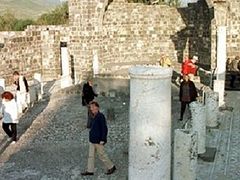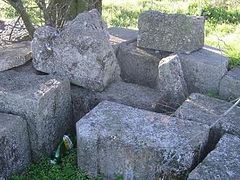Source: Archaeology in Bulgaria
January 13, 2016
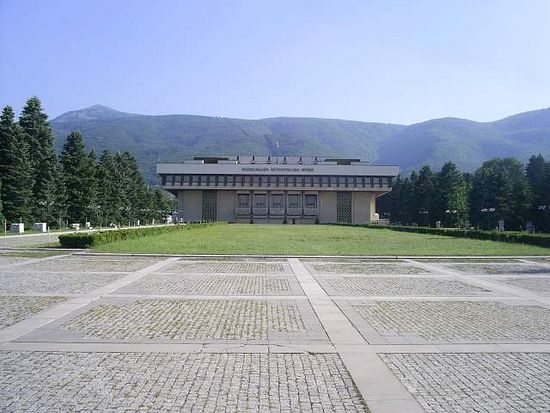 Bulgaria’s National Museum of History is housed in a former government residence of Bulgarian communist dictator Todor Zhivkov (in power 1954/6-1989) in the Boyana Quarter in Sofia’s suburbs. Photo: Svik, Wikipedia
Bulgaria’s National Museum of History is housed in a former government residence of Bulgarian communist dictator Todor Zhivkov (in power 1954/6-1989) in the Boyana Quarter in Sofia’s suburbs. Photo: Svik, Wikipedia
Bulgaria’s National Museum of History in Sofia and the several archaeological, cultural, and historical monuments that it manages saw almost 278,949 visitors in 2015, the Bulgarian Ministry of Culture has announced.
The figure reflects the total number of visitors to the National Museum of History located in Sofia’s Boyana Quarter; the medieval Boyana Church, a UNESCO World Heritage Site known for its 13thcentury (Pre-)Renaissance frescoes and murals; the 11th century Zemen Monastery located in the town of Zemen west of Sofia, which known for its unique architecture and murals; the church in the town of Dobarsko in Southwest Bulgaria built in 1614, and known for its frescoes painted by artists from the Dobasko School of art.
The Boyana Church “St. Nicholas and St. Pantaleon" located in Sofia’s Boyana Quarter, not far from the building of the National Museum of History, retains its position as the most popular branch of the Museum. In 2015, it had almost 50,000 visitors, about 75% of whom were international tourists. (Learn more about the (Pre-)Renaissance Boyana Church in the Background Infonotes below.).
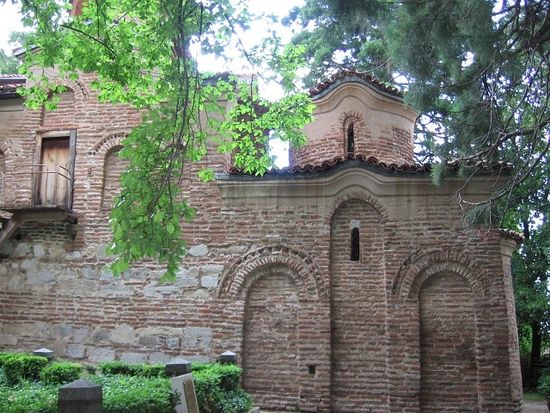 The medieval Boyana Church on the outskirts of Sofia is known for its (Pre-)Renaissance art deserving the status of a UNESCO World Heritage Site. Photo: “Свети места” svetimesta.com
The medieval Boyana Church on the outskirts of Sofia is known for its (Pre-)Renaissance art deserving the status of a UNESCO World Heritage Site. Photo: “Свети места” svetimesta.com
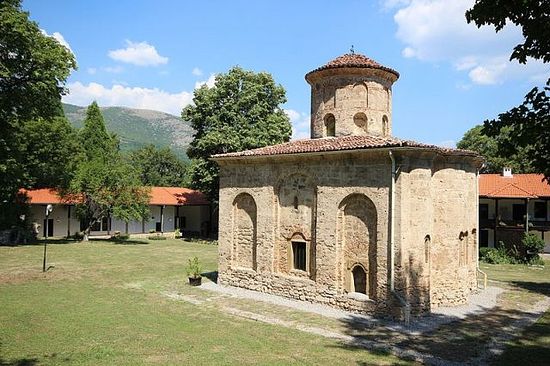 The 11th century monastery St. John the Theologian in Bulgaria’s Zemen. Photo: Bollweevil, Wikipedia
The 11th century monastery St. John the Theologian in Bulgaria’s Zemen. Photo: Bollweevil, Wikipedia
The second most visited branch of the Museum in 2015 was the “St. Theodore Tiron (also known as St. Theodore of Amasea) and St. Theodore Stratelates" Church in the town of Dobarsko, Razlog Municipality, in Southwest Bulgaria. It welcomed a total of 35,045 visitors last year.
The “St. Theodore Tyron and St. Theodore Stratelates" Church in Dobarsko was built in 1614 (there are also hypotheses that the original church was built earlier – according to one inscription, in 1112 AD), i.e. during the period of the Ottoman Yoke (1396-1878/1912) when Bulgaria was part of the Ottoman Empire. It is a small three-nave basilica known for the typical architecture from the time of theOttoman Yoke when the Bulgarians (and the other Christians) were forbidden to build new and largechurches, so the builders would expand the existing churches deeper into the ground.
Thus, from the outside, the Dobarsko Church, not unlike hundreds of other Bulgarian churches from this time period, seems like a minor building which is 8.37 meters long and 6.5 meters wide. However, inside it is 5.2 meters tall. With its three naves, it differs from most of the other churches from that period which had just one nave.
The walls and ceiling of the church in Dobarsko are fully decorated with frescoes and murals, primarily of warrior saints such as St. Demetrius, St. Theodore Tyron, and St. Theodore Stratelates.
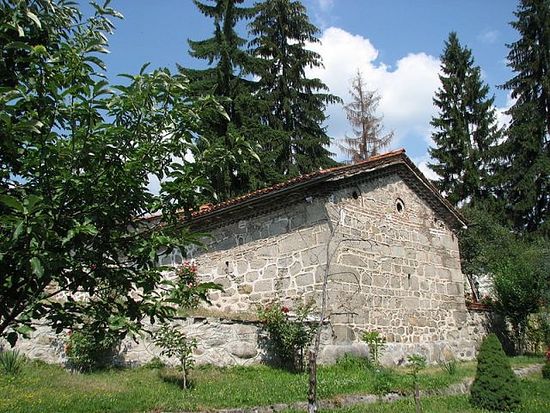 The early 17th century Dobarsko Church in Dobarsko, Southwest Bulgaria, as viewed from the outside. Photo: Nadina, Wikipedia
The early 17th century Dobarsko Church in Dobarsko, Southwest Bulgaria, as viewed from the outside. Photo: Nadina, Wikipedia
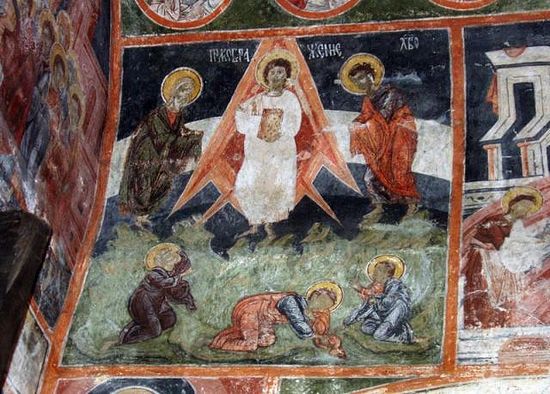 The mural of the Transfiguration of Jesus Christ in the Dobrarsko Church which has been interpreted in media publications as depicting Jesus inside a “space rocket” with images of the Earth’s atmosphere and stratosphere in the background – an interpretation widely criticized by experts. Photo: Pravoslavieto
The mural of the Transfiguration of Jesus Christ in the Dobrarsko Church which has been interpreted in media publications as depicting Jesus inside a “space rocket” with images of the Earth’s atmosphere and stratosphere in the background – an interpretation widely criticized by experts. Photo: Pravoslavieto
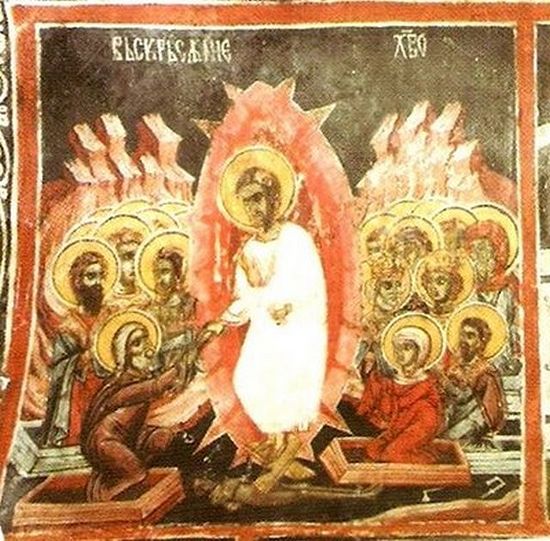 The fresco of the Resurrection of Christ in the Dobrasko Church showing Jesus descending into hell, according to popular media interpretations, inside a “space capsule”. Photo: Pravoslavieto
The fresco of the Resurrection of Christ in the Dobrasko Church showing Jesus descending into hell, according to popular media interpretations, inside a “space capsule”. Photo: Pravoslavieto
The church is known for a mural of the Transfiguration of Jesus which in numerous articles in theBulgarian media has been described as depicting Jesus Christ as “an astronaut rising inside a rocket", with the Earth’s atmosphere and stratosphere in the background, and a mural of God’s Resurrection in which Jesus Christ is said to be descending into hell inside a “space capsule".
These media and popular culture interpretations have been criticized by experts as denigrating thetrue cultural value of the Dobarsko Church and its frescoes but have nonetheless captured the public’s imagination and have contributed to the site’s popularity. The critics point out that what is perceived as a “space rocket" or a “space capsule" is in fact a common depiction of Jesus Christ’s heavenly light found in numerous frescoes and icons elsewhere, at least in the Eastern Orthodox world.
Another alternative interpretation of the frescoes of the saints in the Dobarsko Church argues that their halos seem like helmets, and, for some unknown reason, their arms appear to be “Western [European] halberds".
Bulgaria’s Ministry of Culture points out that the collection of the National Museum of History in Sofia features over 650,000 archaeological, historical, and cultural artifacts presenting Bulgarian and European history since the Prehistory period.
Background Infonotes:
The Boyana Church “St. Nikola and St. Panteleimon" (St. Pantaleon) is a medieval / Early Renaissance Bulgarian church located in today’s Boyana, a suburb of the Bulgarian capital Sofia. It was declared a UNESCO World Heritage site in 1979. It is a two-storey tomb church, with the lower storey designed as a crypt (tomb), and the upper storey – as a chappel for the family of the localfeudal lord.
The earliest construction of the Boyana Church took place at the end of the 10th and the beginning of the 11th century AD when a small one-apse cross dome church was erected. It was expanded in the 13th century when it was turned into a two-storey family tomb church by the local feudal lord, Sebastokrator Kaloyan, ruler of Sredets (today’s Sofia, known as Serdica in the Antiquity period), and his wife, Sebastokratoritsa Desislava, as testified by a donor‘s inscription in the church from 1259 AD. (Sebastokrator (pronounced sevastokrator) was a senior court title in the late Byzantine Empireand in the Bulgarian Empire. It comes from “sebastos" (“venerable", the Greek equivalent of the Latin “Augustus") and “kratоr" (“ruler"). The wife of a sebastokrator was named sebastokratorissa in Greekand sevastokratitsa in Bulgarian.)
A second expansion dates back to the mid 19th century, during Bulgaria’s National Revival period, when residents of the then village of Boyana funded further construction. After Bulgaria’s National Liberation from the Ottoman Empire in 1878, local residents wanted to tear down the Boyana Churchin order to build a bigger one in its place but was saved by Bulgaria’s Tsaritsa-Consort Eleonore (1860-1917), the second wife of Bulgarian Tsar Ferdinand (r. 1887-1918).
The unique murals of the Boyana Church also date back to different periods. The oldest layer is from the 11th-12th century, while the 240 most valuable mural depictions from the second layer date back to 1259 AD. There are also murals from the 14th century, the 16th-17th century, and 1882. The world famous murals from 1259 AD, which have been described by many scholars as Early Renaissnace or precursors of Renaissance Art, are the work of the unknown Boyana Master and his disciples who are believed to have been representatives of the Tarnovo Art School in the Second Bulgarian Empire(1185-1396 AD).
They have sometimes been described as belonging to the tradition of the so called Byzantine Palaiologos (Palaeologus or Palaeologue) Renaissence. In addition to the many biblical scenes, themurals at the Boyana Church feature depictions of Sebastokrator Kaloyan and Sebastokratoritsa Desislava as donors, as well as of Bulgarian Tsar Konstantin Asen Tih (r. 1257-1277 AD) and his wife, Tsaritrsa Irina. Two other small churches preserved in today’s Sofia are also attributed to thedonorship of Sebastokrator Kaloyan. The frescoes of the Boyana Church were restored several times between 1912 and 2006. The Boyana Church was first opened for visitors as a museum in 1977.

